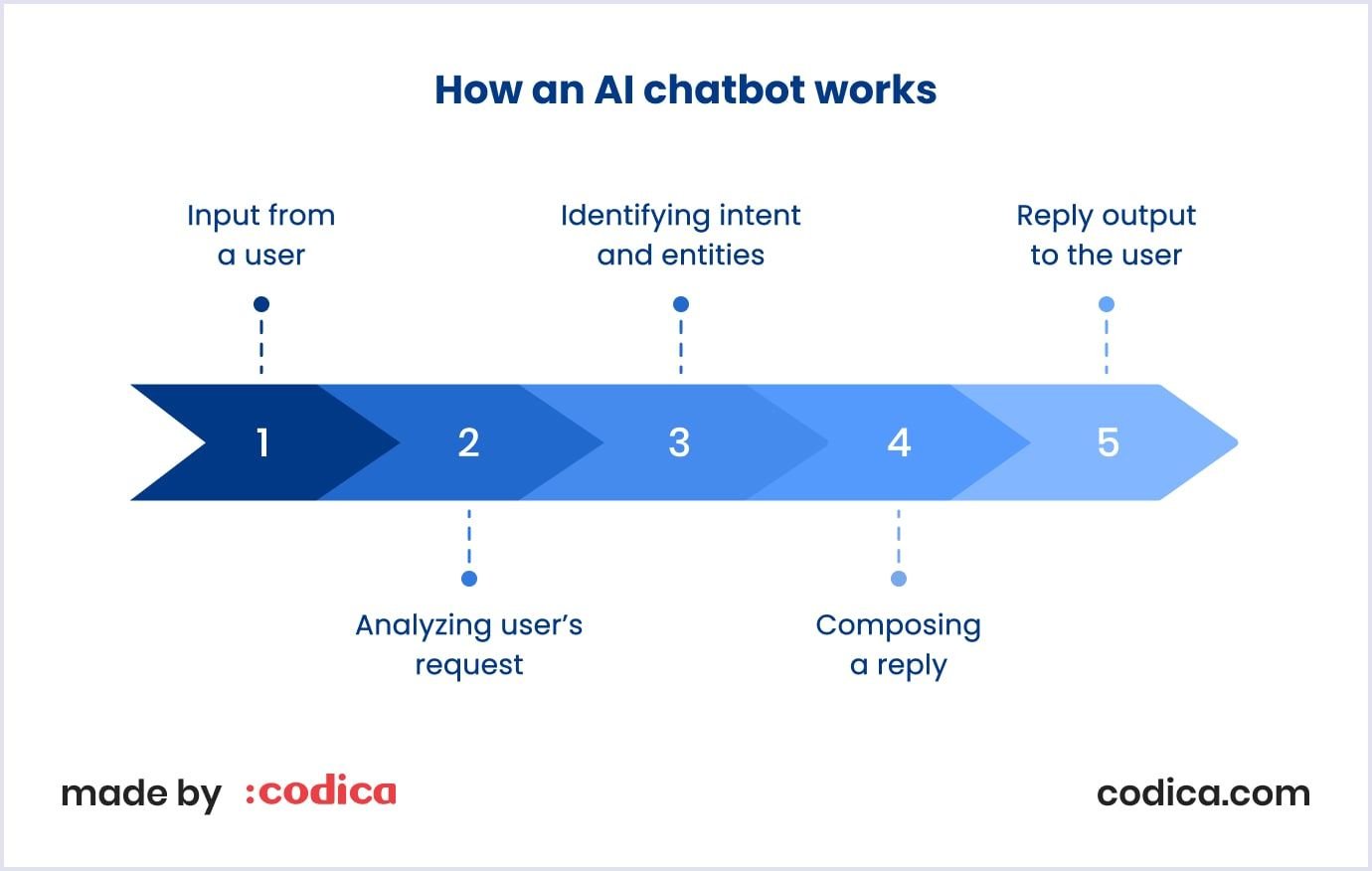Quality customer support is a core obligation for any business aspiring to grow. How well a company serves and supports its customers - has a direct correlation on overall customer satisfaction.
At the heart of a company's customer interactions lies customer engagement, acting as the gateway to the impressions it leaves behind. It’s one of the most important factors customers consider when choosing a service provider. That’s why the world's leading companies are actively investing in a variety of business tools to improve the quality of their customer experience.
What do customers expect? Immediate responses to their inquiries, personalized attention, and 24/7 service availability. Traditional methods such as call centers, emails, etc. are becoming less effective and no longer meet the demands of today's users.
The rise of AI has revolutionized modern marketplace development strategies as AI-powered ecommerce chatbots have become an integral part of effective 24/7 customer support. Chatbots are rightly considered one of the most popular and mainstream digital products built on AI technology. They are adept at handling everything from order tracking to troubleshooting or account management.
In this article, we will conduct a thorough investigation of this matter and break down why this modern solution is so important for your business.
The role of AI chatbots in customer support
Understanding AI chatbots
An AI chatbot is defined as a software application that mimics an interactive human conversation through voice commands or text chat. It uses artificial intelligence and natural language processing (NLP) to figure out what people want instead of directly contacting a live human agent. It guides them to the desired outcome with the least amount of work for the customer.
Chatbots have come a long way since their inception, evolving from simple automated response systems to sophisticated artificial intelligence (AI) technology. These tools have been around for a number of years, but have been used infrequently and more locally.
The world's first chatbot was created by Joseph Weizenbaum at MIT in 1966 and was named ELIZA. Fast forward 58 years. Chatbots have continued to evolve (especially in the last 5 years), and have become an inseparable part of customer service transformation. "For almost as long as we've been making computers, we've been trying to find better, more human ways to talk to them," says David Pierce, senior editor and Vergecast co-host with more than a decade of experience covering consumer technology.
Versatility and integration
Ecommerce AI chatbots have revolutionized customer support by providing personalized interactions and effective problem-solving capabilities.

AI chatbots perform essentially the same tasks as regular chatbots but much more efficiently:
- Process purchase orders for goods and services;
- Replaces technical support by answering customer questions;
- Select related and recommended products to increase checkout;
- Perform sms, push notifications, and email blasts;
- Process monetary transactions;
- Collect feedback and data from website visitors.
The range of applications is wide and will be even wider in the near future. An electronic assistant can be useful wherever communication with the customer is required.
Industries that commonly incorporated chatbot-driven interactions:
- Online shopping - advice on delivery, payment, addresses of delivery points;
- Banks - online calculation of interest on loans and credits;
- Telecom operators - technical support;
- Insurance - help with filling in forms and applications, advice on insurance;
- Online commerce - advice on delivery, payment, and delivery addresses;
- Healthcare - provision of medical supplies, initial consultation, and anamnesis collection;
- Tourism - aggregation of offers, sending of hot tours, booking;
- Education - mailings, invitations to webinars;
- Public services - collection of complaints, quick access to public data;
- HR - selection of suitable resumes, automation of tasks within the company.
By understanding the basic AI principles behind these chatbots, businesses can unlock their full potential and improve the customer support experience.
Read also: How Does AI Improve Online Marketplaces?
Benefits of AI chatbots for marketplaces
Customers aren't the only ones who benefit when a company uses a chatbot. Businesses also reap many benefits, including significant cost savings. As businesses continue to adopt artificial intelligence technologies, chatbots are likely to play an increasingly important role in customer service.
Availability and scalability 24/7
Chatbots aren't people, and they don't get tired. As a result, they don't need breaks and are available 24/7. Surprisingly, they can handle an almost infinite number of customer inquiries. This ensures that customers can get support at any time, regardless of their location or time zone. As your business grows, chatbots can easily scale to handle increased traffic and volume of customer requests.
Improved customer engagement
The first and one of the biggest benefits of chatbots is improved customer interaction. They help to engage both leads and customers, resulting in increased sales. Unlike companies using traditional customer service methods, chatbots do not overwhelm the audience with information, but instead provide only the data that is relevant to the user's query at any given time. According to Timetrade, companies can lose up to 75% of their customers due to long response times.
Therefore, customers are provided with highly relevant information on a regular basis. This approach helps to keep the audience engaged for longer due to the automated message chain.
Personalized customer experience
Chatbots equipped with artificial intelligence technologies have the ability to personalize customer interactions based on past behavior and preferences. By analyzing this customer data, chatbots can make tailored recommendations, suggest relevant products, and provide personalized assistance, creating a more engaging and personalized experience for customers.
Cost efficiency
Business owners need to pay employees to provide customer service. And as the business grows, so do the costs. Marketplace bots are a one-time investment that helps brands reduce spending on employees. Businesses can easily integrate chatbots to answer simple questions from potential customers and refer more complex questions to service managers.

Implementing AI chatbots in marketplaces
Now that you know the incredible benefits ecommerce chatbots can bring to you and your customers, you're ready to start thinking about how to integrate them into your website. Follow these steps to get the best results.

Step 1: Determining the target
Analyze the marketplace's guidelines and policies around the use of AI chatbots for ecommerce. Ensure your chatbot complies with the marketplace's terms of service, data privacy regulations, and user experience standards.
Step 2: Choosing the right AI chatbot platform
Evaluate different AI chatbot platforms based on features, pricing, integration capabilities, and the level of customization offered. Best AI chatbots for ecommerce customer service include: Botkit, Amazon Lex, IBM Watson Assistant, Google Dialogflow, Microsoft Bot Framework, and others.
Popular AI chatbot platforms
| Platform | Description | Features | Pricing |
| Botkit |
|
|
|
| Amazon Lex | AWS service for creating conversational interfaces using automatic speech recognition and natural language understanding. |
|
|
| IBM Watson Assistant | AI-powered virtual agent platform from IBM. Utilizes natural language processing and machine learning to respond to user queries. |
|
|
| Microsoft Bot Framework | Open-source platform for creating intelligent chatbots that work across various communication channels. |
|
|
| Dialogflow (Google) | Google's platform for building chatbots and virtual agents. Uses natural language processing and machine learning technologies. |
|
|
| Kore.ai | Platform for building virtual assistants and chatbots with advanced functionality. Uses NLP, machine learning, integration with back-office systems. |
|
|
| SAP Conversational AI | Chatbot and virtual assistant platform from SAP, designed for enterprise applications and integration with SAP systems. |
|
|
Step 3: Design the chatbot conversation flow
Map out the typical user journeys and scenarios your chatbot needs to handle, such as product search, recommendations, order placement, and customer support. Develop conversational scripts and responses that provide a natural and helpful user experience.
Step 4: Integrate the chatbot with the marketplace
Establish the necessary APIs and integrations between the chatbot platform and the marketplace's systems, such as product catalogs, order management, and customer databases. Ensure seamless data exchange and smooth handoffs between the chatbot and the marketplace's other functions.
Step 5: Train and fine-tune the chatbot
Continuously feed the chatbot with conversational data and user feedback to improve its natural language understanding and response generation. Monitor the chatbot's marketplace performance metrics, such as user satisfaction, conversion rates, and escalations to human agents.
Step 6: Deployment and scalability
Decide on the deployment strategy and ensure the chatbot can scale up or down as needed. Regularly review and update the chatbot to keep up with evolving user needs
By following these steps, you can successfully implement an AI chatbot that seamlessly integrates with your marketplace, enhancing the user experience and driving business growth.
AI chatbot implementation: challenges and solutions
Undoubtedly, introducing AI chatbots into a business will set it apart from its competitors and make it much more customer-centric. However, there are some serious issues that need to be carefully considered. These lie in the areas of data security, managing complex user requests, and continuously improving capabilities.
| Challenge | Description | Solution |
| Data privacy and security | Marketplaces often handle sensitive user and transaction data, which needs to be protected from breaches and misuse. |
|
| Handling complex queries | Ecommerce AI chatbots for the marketplace need to be able to assist users with a wide range of queries, from product information and order status to returns and customer support. Effectively handling these complex and varied queries is crucial. |
|
| Continuous improvement | As user needs and marketplace operations evolve, ecommerce AI chatbots must continuously adapt and improve to maintain its effectiveness and relevance. |
|
Should be noted, that while AI chatbots can handle many routine customer inquiries, they aren't intended to completely replace customer service agents. Instead, they can work alongside human agents to handle simpler tasks, allowing humans to focus on more complex issues that require empathy, creativity, and problem-solving skills.
Successful AI chatbot use cases in marketplaces
IKEA’s Place App

IKEA, the Swedish furniture retailer, launched an augmented reality mobile app called "IKEA Place" that allows customers to virtually place IKEA products in their homes before making a purchase. The app uses AI-powered object recognition and spatial awareness to provide an accurate representation of how the furniture would look in the customer's living space.
Sephora

Sephora, the global cosmetics retailer, developed an AI-powered "Virtual Artist" feature that allows customers to virtually try on different makeup products using their device's camera. This helps customers experiment with various shades and styles before making a purchase.
Macy’s On-Call

Macy's, the American department store chain, launched an AI-powered chatbot called "On-Call" to help customers with a variety of tasks, such as finding products, checking order status, and even scheduling in-store appointments.
Codica’s expertise in AI implementation and development
Codica has proven its high level of expertise in AI development services, evidenced by successfully implementing more than 50 AI projects.
Working with us is a personalized approach aimed at achieving measurable business results. We also guarantee compliance with security standards and provide 24/7 technical support. Partnering with us will help you stay at the forefront of innovation and awe your customer's attention.
The future of AI chatbots in marketplaces
Chatbots have come a long way from their original form, with natural language processing and artificial intelligence allowing new technologies to be quickly integrated into our daily lives. As AI continues to evolve, we can expect chatbots to improve as well. Soon, it will be impossible to tell whether you are talking to an online bot or a real person.
The rise of ecommerce marketplace development has fueled the demand for intelligent chatbots that can provide seamless customer support and personalized shopping experiences. These AI-powered assistants are reshaping how consumers interact with online retail platforms.
Chatbots of the future will continue to bridge the gap between robotic and human verbal and text communication, while becoming more emotionally sensitive and autonomous. With advances in technology happening every day, who knows what the next step in their evolution will be. The development of AI technology is happening quickly, and we'll see more companies get involved, leading to wider adoption and integration.
Interacting with a chatbot may eventually become as seamless as communicating with a human.
Conclusion
Integrating chatbots into your customer service isn't just a smart move, it's essential if you want to keep up with the pace of today's world and meet the ever-increasing expectations of your customers.

